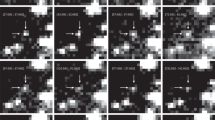Abstract
The prompt optical emission that arrives with the γ-rays from a cosmic γ-ray burst (GRB) is a signature of the engine powering the burst, the properties of the ultra-relativistic ejecta of the explosion, and the ejecta's interactions with the surroundings1,2,3,4,5. Until now, only GRB 990123 had been detected6 at optical wavelengths during the burst phase. Its prompt optical emission was variable and uncorrelated with the prompt γ-ray emission, suggesting that the optical emission was generated by a reverse shock arising from the ejecta's collision with surrounding material. Here we report prompt optical emission from GRB 041219a. It is variable and correlated with the prompt γ-rays, indicating a common origin for the optical light and the γ-rays. Within the context of the standard fireball model of GRBs, we attribute this new optical component to internal shocks driven into the burst ejecta by variations of the inner engine. The correlated optical emission is a direct probe of the jet isolated from the medium. The timing of the uncorrelated optical emission is strongly dependent on the nature of the medium.
This is a preview of subscription content, access via your institution
Access options
Subscribe to this journal
Receive 51 print issues and online access
$199.00 per year
only $3.90 per issue
Buy this article
- Purchase on Springer Link
- Instant access to full article PDF
Prices may be subject to local taxes which are calculated during checkout




Similar content being viewed by others
References
Meszaros, P. & Rees, M. Optical and long-wavelength afterglow from gamma-ray bursts. Astrophys. J. 476, 232–237 (1997)
Meszaros, P. & Rees, M. GRB 990123: reverse and internal shock flashes and late afterglow behaviour. Mon. Not. R. Astron. Soc. 306, L39–L43 (1999)
Sari, R. & Piran, T. Predictions for the very early afterglow and the optical flash. Astrophys. J. 520, 641–649 (1999)
Zhang, B., Kobayashi, S. & Meszaros, P. Gamma-ray burst early optical afterglows: Implications for the initial Lorentz factor and the central engine. Astrophys. J. 595, 950–954 (2003)
Nakar, E. & Piran, T. Early afterglow emission from a reverse shock as a diagnostic tool for gamma-ray burst outflows. Mon. Not. R. Astron. Soc. 353, 647–653 (2004)
Akerlof, C. et al. Observation of contemporaneous optical radiation from a gamma-ray burst. Nature 398, 400–402 (1999)
Gotz, D., Mereghetti, S., Shaw, S., Beck, M. & Borkowski, J. GRB 041219 — A long GRB detected by INTEGRAL. GRB Circ. Netw., 2866 (2004)
Barthelmy, S. et al. Swift-BAT detection of the bright long burst GRB 041219. GRB Circ. Netw., 2874 (2004)
Paciesas, W. et al. The fourth BATSE gamma-ray burst catalog (revised). Astrophys. J. Supp. 122, 465–495 (1999)
Vestrand, W. T. et al. The RAPTOR experiment: a system for monitoring the optical sky in real time. Proc. SPIE 4845, 126–136 (2002)
Blake, C. & Bloom, J. S. GRB 041219: Infrared afterglow candidate. GRB Circ. Netw., 2870 (2004)
Schlegel, D. J., Finkbeiner, D. P. & Davis, M. Maps of dust IR emission for use in estimation of reddening and CMBR foregrounds. Astrophys. J. 500, 525–553 (1998)
Hearty, F. et al. NIR observations of GRB 041219. GRB Circ. Netw., 2916 (2004)
Henden, A. GRB 041219, BVRcIc field calibration. GRB Circ. Netw., 2871 (2004)
Panaitescu, A. & Kumar, P. Analysis of two scenarios for the early optical emission of the gamma-ray burst afterglow 990123 and 021211. Mon. Not. R. Astron. Soc. 353, 511–522 (2004)
Kulkarni, S. R. et al. Discovery of a radio flare from GRB 990123. Astrophys. J. 522, L97–L100 (1999)
Katz, J. I. Low-frequency spectra of gamma-ray bursts. Astrophys. J. 432, L107–L109 (1994)
Liang, E. P., Crider, A., Bottcher, M. & Smith, I. A. GRB 990123: The case for saturated Comptonization. Astrophys. J. 519, L21–L24 (1999)
Blake, C. H. et al. An infrared flash contemporaneous with the γ-rays from GRB 041219a. Nature doi:10.1038/nature03520 (this issue)
Vestrand, W. T. et al. RAPTOR: Closed-loop monitoring of the night sky and the earliest optical detection of GRB 021211. Astron. Nachr. 325(6–8), 549–552 (2004)
Li, W., Filippenko, A., Chornock, R. & Jha, S. The early light curve of the optical afterglow of GRB 021211. Astrophys. J. 586, L9–L11 (2003)
Fox, D. et al. Discovery of early optical emission from GRB 021211. Astrophys. J. 586, L5–L8 (2003)
van Paradijs, J., Kovouveliotu, C. & Wijers, R. A. M. J. Gamma-ray burst afterglows. Annu. Rev. Astron. Astrophys. 38, 379–425 (2000)
Stanek, K. Z. et al. Spectroscopic discovery of the supernova 2003dh associated with GRB 0303299. Astrophys. J. 591, L17–L20 (2003)
Hjorth, J. et al. A very energetic supernova associated with the gamma-ray burst of 29 March 2003. Nature 423, 847–850 (2003)
Waxman, E. Gamma-ray burst afterglow: supporting the cosmological fireball model, constraining parameters, and making predictions. Astrophys. J. 485, L5–L8 (1997)
Sari, R., Piran, T. & Narayan, R. Spectra and light curves of gamma-ray burst afterglows. Astrophys. J. 497, L17–L20 (1998)
Gehrels, N. et al. The Swift gamma-ray burst mission. Astrophys. J. 611, 1005–1020 (2004)
Cenko, S. B. GRB 041219: optical afterglow detection. GRB Circ. Netw. 2886 (2004)
Fenimore, E. et al. Swift-BAT time history of GRB 041219. GRB Circ. Netw. 2906 (2004)
Acknowledgements
The RAPTOR project is supported by the Laboratory Directed Research and Development programme at Los Alamos National Laboratory.
Author information
Authors and Affiliations
Corresponding author
Ethics declarations
Competing interests
The authors declare that they have no competing financial interests.
Supplementary information
Supplementary Discussion
Extra discussion of the methods and results of the study, with additional references. (DOC 24 kb)
Rights and permissions
About this article
Cite this article
Vestrand, W., Wozniak, P., Wren, J. et al. A link between prompt optical and prompt γ-ray emission in γ-ray bursts. Nature 435, 178–180 (2005). https://doi.org/10.1038/nature03515
Received:
Accepted:
Issue Date:
DOI: https://doi.org/10.1038/nature03515
Comments
By submitting a comment you agree to abide by our Terms and Community Guidelines. If you find something abusive or that does not comply with our terms or guidelines please flag it as inappropriate.



